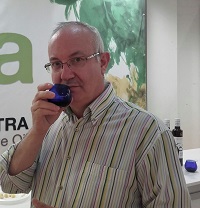Bartolomé Ortega Moreno was born in Fuerte del Rey (Jaen) and from childhood has been closely linked to the olive grove and olive oil. He graduated in Olive Growing and Olive Oil Technology with a Masters in Olive Grove, Olive Oil and Health from the University of Jaen.
He currently works as an official in the Ministry of Agriculture, Food and Environment of Spain.
He is member of the tasting panel for olive oil of CITOLIVA (Technology Centre for Olive Groves and Olive Oil).


